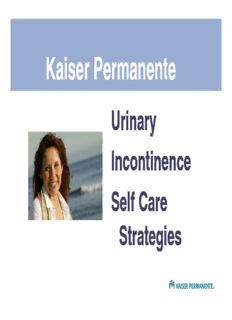
My Doctor Online - Kaiser Permanente PDF
Preview My Doctor Online - Kaiser Permanente
Kaiser Permanente Urinary Incontinence Self Care Strategies Urinary Incontinence Self Care Tips The goal of this presentation is to help you manage urinary incontinence. You will learn about: • how the urinary system works • the different kinds of incontinence and self care strategies to manage your problem • how to perform Kegel exercises so that they actually work to help your problem Myths and Facts About Incontinence Myths Facts 15-25 million Americans No one else has this have problems with problem. incontinence. 26% of women age 30-59 Only old people have have problems with incontinence. incontinence. Research has shown that pelvic floor exercise, dietary There is nothing you can do and behavioral modification to help yourself. can help or cure incontinence. How the Bladder Works- Urine is made in the kidneys and flows into the bladder at about 15 drops per minute. The bladder is a hollow organ that stores urine. As the bladder fills, the muscle over the bladder stretches. When your bladder is full, it signals you that it is time to void. The bladder normally holds about 2 cups of urine. The Voiding Reflex When you urinate, the muscle over the bladder contracts while the pelvic floor muscles relax. Bladder When you contract your pelvic floor muscles, the bladder is signaled to relax and stop emptying. Childbirth Graphics 1998 Types of Incontinence Stress Incontinence Urge Incontinence Mixed Incontinence Overactive Bladder Functional Incontinence Stress Incontinence Definition: involuntary loss of urine with increased intra-abdominal pressure Symptoms: loss of a small amount of urine with exertion (cough, sneeze, lift) Cause: pelvic floor weakness or loss of support for the bladder Other names: stress urinary incontinence (old name: genuine stress incontinence – GSI) How Could this Happen to Me? Stress Incontinence: Weak/damaged pelvic floor muscles associated with things such as difficult vaginal childbirth, chronic constipation, history of heavy lifting or high impact sports. Urge Incontinence Definition: involuntary loss of urine with a strong urge to urinate Symptoms: loss of a large amount of urine associated with an irritant or trigger (running water, walking by the bathroom, putting the key in the lock, nervousness, leaking on the way to the bathroom) Causes: uninhibited bladder contractions Overactive Bladder Definition: Urinating more than 7 times within 24 hours. Symptoms: A strong urge to urinate without leakage; associated with frequency. Cause: Going to the bathroom just in case, high intake of bladder irritants, worry or anxiety regarding leaking.
Description: